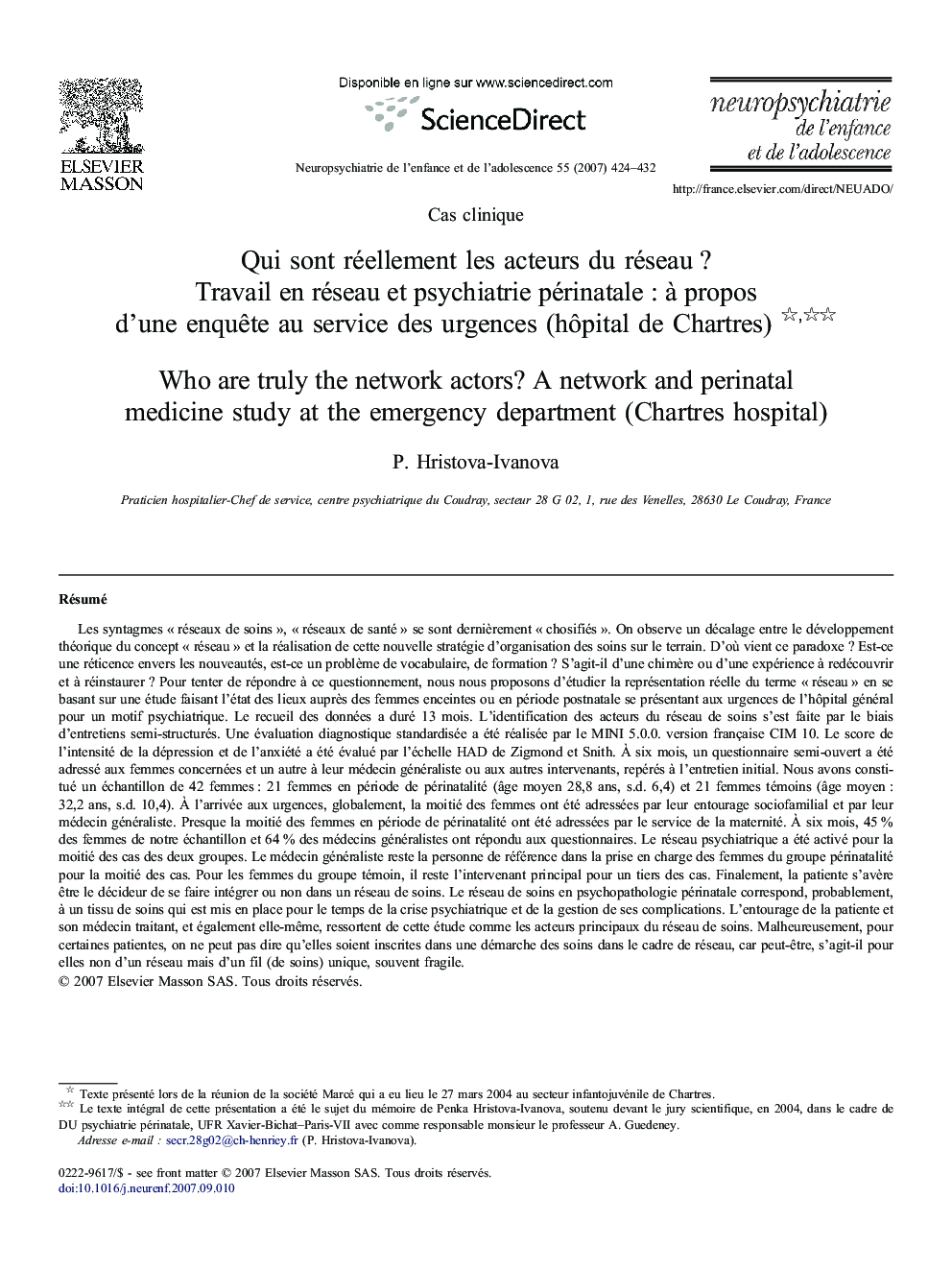| کد مقاله | کد نشریه | سال انتشار | مقاله انگلیسی | نسخه تمام متن |
|---|---|---|---|---|
| 944536 | 925611 | 2007 | 9 صفحه PDF | دانلود رایگان |

RésuméLes syntagmes « réseaux de soins », « réseaux de santé » se sont dernièrement « chosifiés ». On observe un décalage entre le développement théorique du concept « réseau » et la réalisation de cette nouvelle stratégie d'organisation des soins sur le terrain. D'où vient ce paradoxe ? Est-ce une réticence envers les nouveautés, est-ce un problème de vocabulaire, de formation ? S'agit-il d'une chimère ou d'une expérience à redécouvrir et à réinstaurer ? Pour tenter de répondre à ce questionnement, nous nous proposons d'étudier la représentation réelle du terme « réseau » en se basant sur une étude faisant l'état des lieux auprès des femmes enceintes ou en période postnatale se présentant aux urgences de l'hôpital général pour un motif psychiatrique. Le recueil des données a duré 13 mois. L'identification des acteurs du réseau de soins s'est faite par le biais d'entretiens semi-structurés. Une évaluation diagnostique standardisée a été réalisée par le MINI 5.0.0. version française CIM 10. Le score de l'intensité de la dépression et de l'anxiété a été évalué par l'échelle HAD de Zigmond et Snith. À six mois, un questionnaire semi-ouvert a été adressé aux femmes concernées et un autre à leur médecin généraliste ou aux autres intervenants, repérés à l'entretien initial. Nous avons constitué un échantillon de 42 femmes : 21 femmes en période de périnatalité (âge moyen 28,8 ans, s.d. 6,4) et 21 femmes témoins (âge moyen : 32,2 ans, s.d. 10,4). À l'arrivée aux urgences, globalement, la moitié des femmes ont été adressées par leur entourage sociofamilial et par leur médecin généraliste. Presque la moitié des femmes en période de périnatalité ont été adressées par le service de la maternité. À six mois, 45 % des femmes de notre échantillon et 64 % des médecins généralistes ont répondu aux questionnaires. Le réseau psychiatrique a été activé pour la moitié des cas des deux groupes. Le médecin généraliste reste la personne de référence dans la prise en charge des femmes du groupe périnatalité pour la moitié des cas. Pour les femmes du groupe témoin, il reste l'intervenant principal pour un tiers des cas. Finalement, la patiente s'avère être le décideur de se faire intégrer ou non dans un réseau de soins. Le réseau de soins en psychopathologie périnatale correspond, probablement, à un tissu de soins qui est mis en place pour le temps de la crise psychiatrique et de la gestion de ses complications. L'entourage de la patiente et son médecin traitant, et également elle-même, ressortent de cette étude comme les acteurs principaux du réseau de soins. Malheureusement, pour certaines patientes, on ne peut pas dire qu'elles soient inscrites dans une démarche des soins dans le cadre de réseau, car peut-être, s'agit-il pour elles non d'un réseau mais d'un fil (de soins) unique, souvent fragile.
The syntagms "care networks" and "health networks" have lately been reified. One notes a discrepancy between the theoretical development of the "network" concept and the accomplishment of this new care organisation in the field. Where does that paradox come from? Is it from reluctance towards change, from a vocabulary problem, or from training? Is it a myth or an experiment that needs to be rediscovered and re-established? We suggest attempting to answer this question by studying the real representation of the term "network" based on a study of pregnant women or women in the post-natal period, who presented themselves to the emergency department of a general hospital for a psychiatric motive. The data collection lasted 13 months. The identification of the network actors was based on semi-structured interviews. A standardised diagnostic evaluation was made by the Mini International Neuropsychiatric Interview 5.0.0. French version International Classification of Diseases-10. The depression and anxiety intensity rank was measured by the Hospital Anxiety and Depression scale by Zigmond and Snith. At 6 months stage, semi-open questionnaire was addressed to the women and another to their general practitioner or other intervening persons noted at the initial interview. We built up a sample of 42 women: 21 women in the perinatal period (average age: 28.8 years old, s.d. 6.4), and 21 control women (average age: 32.2 years old, s.d. 10.4). Globally, on arriving at the Emergency department, half of the women were sent by their socio-domestic circle and by their general practitioner. Almost half of the women in the perinatal period were sent by the maternity department. At 6 months, 45% of the women and 64% of the general practitioners answered the questionnaires. The psychiatric network was activated for half the cases in both groups. For half of the cases, the general practitioner remains the reference person in assuming care of the women in the perinatal period. As for the control women, general practitioner remains the main intervening person for a third of the cases. Eventually the patient turns out to be the one that decides whether or not to become integrated in one of the care networks. The healthcare network in perinatal psychopathology probably corresponds to a group of treatments that is put in place as long as the psychiatric crisis and the control of its complications lasts. The patient's circle and her general practitioner, as well as the patient, show up as the main participants of the care network. Unfortunately for some patients, one cannot say they are registered in a care network, perhaps because their care consists of a single treatment, which is often weak.
Journal: Neuropsychiatrie de l'Enfance et de l'Adolescence - Volume 55, Issue 7, November 2007, Pages 424–432